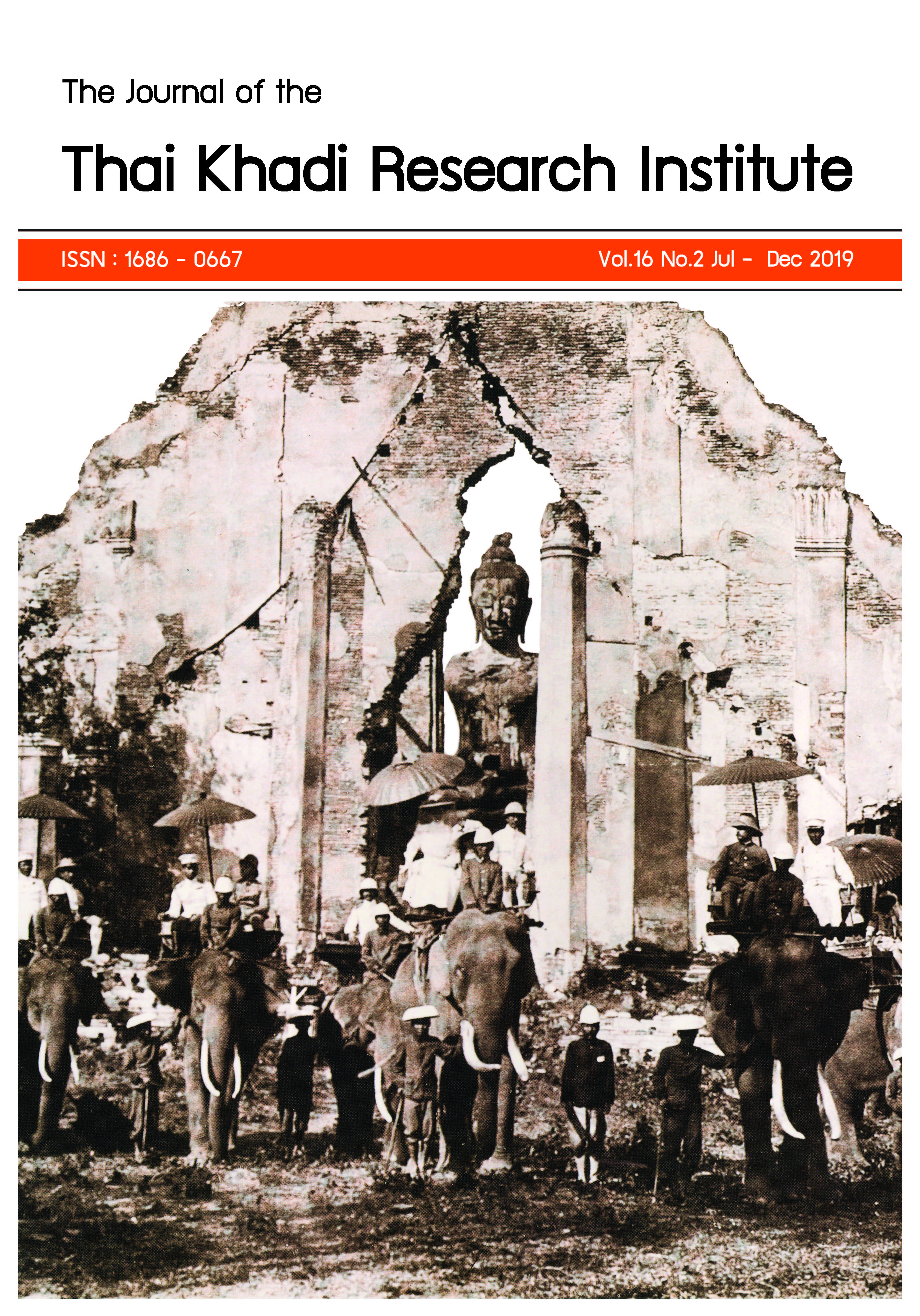การเปลี่ยนแปลงอัตลักษณ์ “คนเผาผี” ในเขตชุมชนเมืองนครศรีธรรมราช
Main Article Content
บทคัดย่อ
บทความวิจัยนี้ มีวัตถุประสงค์เพื่อศึกษาการเปลี่ยนแปลงอัตลักษณ์ของ “คนเผาผี” ในเขตชุมชน เมืองนครศรีธรรมราช ในช่วง พ.ศ. 2500 - 2561 โดยมีพื้นที่ในการศึกษา ได้แก่ พื้นที่ฌาปนสถานวัดชะเมา ตำบลท่าวัง วัดบุญนารอบ (จำปาขอม) วัดชลเฉนียน (ชายคลอง) ตำบลในเมือง อำเภอเมือง จังหวัดนครศรีธรรมราช ด้วยวิธีวิจัยเชิงคุณภาพ ภายใต้แนวคิด Identity เก็บข้อมูลจากเอกสาร และจากภาคสนาม จากการสังเกตแบบไม่มีส่วนร่วม (Non - participation observation) และการสัมภาษณ์แบบเจาะลึก (In - depth Interview) จากผู้ให้ข้อมูล ได้แก่ กลุ่มผู้อาวุโสในชุมชน พระสงฆ์ และคนเผาผี ข้อมูลที่ได้จะถูกนำมาจำแนกหมวดหมู่ ตีความ สร้างข้อสรุป และนำเสนอด้วยวิธีการวิเคราะห์เชิงพรรณนา
ผลการศึกษา การเปลี่ยนแปลงอัตลักษณ์ของ “คนเผาผี” ในเขตชุมชนเมือง นครศรีธรรมราช ในช่วง พ.ศ. 2500 - 2561 พบว่า กระบวนการกลายเป็นคนเผาผีมีวิถีที่แตกต่างกัน กล่าวคือ สืบทอดรุ่นสู่รุ่น จากการบวชเรียนลาสิกขามาเป็นคนเผาผี และจากการเป็นคนลงเต็นท์บริการงานศพผันตัวมาเป็นคนเผาผี ในส่วนของอัตลักษณ์ของคนเผาผีนั้น เปลี่ยนแปลงเด่นชัดและแตกต่างกันออกไปตามแต่ละยุคสมัย 3 ยุค กล่าวคือ 1) คนเผาผียุคเชิงตะกอน (พ.ศ. 2500 - 2520) จะมีอัตลักษณ์คนชั้นต่ำ น่ากลัว กินข้าววัด นอนศาลา ได้เมียหมา ห่มผ้าผี เป็นเจ้าคาถา / เจ้าพิธี เป็นคนบุญไม่ใช่คนบาป 2) คนเผาผียุคเมรุเผาศพเตาถ่านไฟ (พ.ศ. 2520 - 2540) จะมี อัตลักษณ์ที่เป็นเจ้าหน้าที่ประจำเมรุ พร้อมพรั่งด้วยคาถา มีดศาสตราคืออาวุธ และ 3) คนเผาผียุคเมรุเผาศพเตาไฟฟ้า (พ.ศ. 2540 - 2561) จะมีอัตลักษณ์ใส่สูทเผาศพ แม้ทันสมัยแต่ยังใส่ใจในกฎ / ผิดกฎชดใช้กรรม หากินกับศพ / เห็นเงินเป็นใหญ่ High Skill: ช่างเทคนิคซ่อมเตาเผาศพไฟฟ้า คนเผาผียุคใหม่ขายไก่ย่าง คนเผาผีไฮเทค: ใช้ Facebook Line สื่อสารรับงานศพ เป็นผู้ประกอบการงานศพ
Downloads
Article Details
ผู้เขียนจะต้องลงนามในแบบฟอร์มรับรองบทความ เพื่อให้คำยืนยันความรับผิดชอบว่า บทความของผู้เขียนนั้นไม่เคยตีพิมพ์ที่ใดมาก่อน พร้อมรับทราบว่า กระบวนการส่งบทความเข้าพิจารณาและตีพิมพ์ในวารสารไทยคดีศึกษานั้น จะไม่มีการเรียกเก็บค่าใช้จ่ายในการดำเนินการ ยกเว้น ในกรณีที่ผู้เขียนขอยกเลิกการตีพิมพ์บทความในวารสารไทยคดีศึกษาไม่ว่าด้วยสาเหตุใด และหลังจากบทความนั้นเข้าสู่กระบวนการพิจารณาของผู้ทรงคุณวุฒิไปแล้ว ผู้เขียนจะต้องรับผิดชอบต่อค่าใช้จ่ายที่เกิดขึ้นในกระบวนการประเมินเป็นจำนวนเงิน 3,000 บาท (สามพันบาทถ้วน)
เอกสารอ้างอิง
Fuangfusakul, A. (2003). Attalak [Identity]. Bangkok: National Research Council Thailand.
Giddens, A. (1992). The Transformation of Intimacy Sexuality, Love, and Eroticism in Modern Societies. Stanford University Press.
Hall, S. (1996). Questions of Cultural Identity. London: SAGE.
Jitniratana, N. (2010). Attalak chumchon [Community Identities]. Songkla: Thaksin University.
Lertsukprasert, P. (2005). Krabūankān klāi pen sinkhā khō̜ng phithīkam ngān sop [Commoditization of funeral services]. Bangkok: Chulalongkorn University.
Luengaramsri, P. (1998). Attalak chāttiphan læ khwāmpen chāi khō̜p [Ethnic Identity and Marginalization]. Bangkok: O.S. Printing House.
Manittayakun, C. (2007). Withī chīwit sapparœ̄ nai Krung Thēp Mahā Nakhō̜n [Alternative: Way of life of the undertakers in Bangkok Metropolitan]. Bangkok: Silpakorn University.
Na Nakorn, V. (2008). Phithī sop phāk tai, in sārānukrom watthanatham Thai phāk tai [Southern Funeral Ceremony, in Encyclopedia of Southern Thai Culture]. Bangkok: Encyclopedic Cultural Foundation, Thailand.
Noonsuk, P. (1998). Prawattisāt thō̜ngthin nakhō̜n sī tham rāt [Local history of Nakhon Si Thammarat]. Nakhon si thammarat: Nakhon si thammarat Ratchaphat Institute.
Praphiphatpong. (2001). Kān plīanplǣng kānčhat ngān sop khō̜ng chāo phut kō̜ranī sưksā bān mun tambon nāprang ʻamphœ̄ pong čhangwat Phayao [A Study on Changes in Buddhists’ Funeral Ceremony: A Case Study on Banmoon Village, Naprang Sub-District, Pong District, Phayao Province]. (Master’s thesis, Mahachulalongkornrajavidyalaya Universiry).
PramahaJaran. (2553). Kānsưksā nǣokhit khwām chư̄a chœ̄ng watthanatham nai kānsāng prāsāt sop khō̜ng chāo phut lānnā [Study of Cultural Concept of Lanna Buddhist on Small Castle Construction for the Corpse]. (Master’s thesis, mahachulalongkornrajavidyalaya Universiry).
Pongpaiboon, S. (2001). Khrōngsāng læ phonlawat watthanatham phāk tai kap kānphatthanā [Structure and Cultural Dynamics of the Southern with Development]. Bangkok: The Thailand Research Fund.
Photčhanānukrom chabap rātchabanthittayasathān Phō̜.Sō̜. sō̜ngphanhārō̜ihāsipsī [The Royal Institute Dictionary 2011]. (2017). Retrieved September 12, 2017, from http://www.royin.go.th/dictionary/.
Satienkoset. (1998). Kānsưksā rư̄ang praphēnī Thai [Study of Thai traditions]. Bangkok: Bophit Printing Co., Ltd.
Wongtad, P. (1991). Phithīkam kīeokap khwāmtāi nai prathēt Thai [Rituals about Death in Thailand]. Bangkok: Amarin Printing.
Interviewees:
Boonchai (alias). Crematory of Cholchanian Temple, Nai Muang, Muang Nakhon Si Thammarat. 17 December 2017.
Dam (alias). Crematory of Chamao Temple, Tha Wang, Muang Nakhon Si Thammarat. 15 November 2017.
Prakrusamusomtob (alias). Boonarop Temple, Tha Wang, Muang Nakhon Si Thammarat. 20 September 2017.
Prapaladkasem (alias). Chamao Temple, Tha Wang, Muang Nakhon Si Thammarat. 5 September 2017.
Parksopoe, P. Boonarop Temple, Tha Wang, Muang Nakhon Si Thammarat. 4 November 2017.
Seingloy, A. Crematory of Cholchanian Temple, Nai Muang, Muang Nakhon Si Thammarat. 23, 26 November 2017.
Watthanapoka, T. Crematory of Chamao Temple, Tha Wang, Muang Nakhon Si Thammarat. 3 December 2017.
Wongmaksakul, P. Boonarop Temple, Tha Wang, Muang Nakhon Si Thammarat. 10 September 2017, 9 December 2017.


